Developer: Tecmo Publisher: Tecmo Release: 08/91 Genre: Action
Back in the day it wasn’t uncommon for games to undergo significant changes when coming to different markets. Sometimes these were bug fixes or additions to gameplay. More often than not games were made harder for the US market and even more difficult for Europe. For the most part it was harmless but occasionally publishers should have left well enough alone. Ninja Gaiden III saw significant changes before coming to the US, changes that make an excellent game merely good when it should have been better.
Although it is the third in the series chronologically Ninja Gaiden 3 is the second title and clears up loose ends from the first game. Irene Lew is investigating a mysterious lab when she is chased and killed by….Ryu? Of course it isn’t the genuine article as the real Ryu later shows up to clear his name. Familiar faces from the past return as this installment eschews ancient mysticism for bio creatures and technology.
Ninja Gaiden III saw a change in director for the series and it is almost immediately apparent someone else was at the helm. The pace is slower through more elaborate level design and enemy placement. Ryu is much more agile and is able to jump higher. The ability to climb hand over hand on most surfaces makes a return from the arcade game. However the most prominent changes come in the weapons.
Continuing the tradition of adding and taking away the shadow doppelgangers are no more. Making good use of them was tricky but their presence really added to Ninja Gaiden 2. In their place is probably the best addition to the game, the dragon sword. This upgrade extends the length of the blade and also cuts enemies without needing to crouch. What makes it even better is you can still keep another secondary weapon after picking it up. The only other new addition is the vacuum wave, which sends blades of energy above and below you. It might sound limited but thanks to the level design you’ll use it extensively.
There are numerous quality of life improvements that make this a smoother experience. Item candles are transparent, allowing you to see their contents. For anyone that suffered through the first game enemies no longer respawn if you move two inches. Words cannot express how much this was necessary. The ability to hang and climb hand over hand is used extensively throughout the game. The levels are far more vertical and full of environmental hazards, a carryover from the second game. While the jumping mechanics have been changed slightly platforming is no less difficult than before. The levels are far more populated even though enemy respawning has been eliminated. The game doesn’t know the meaning of restraint in this regard to its detriment.
The Ninja Gaiden series has always prided itself on its difficulty and part 3 is the toughest yet. The US version of the game is more difficult, and in some ways it hurts the game. Enemies deal more damage and the difficulty curve ramps up a lot sooner. By the midpoint it isn’t uncommon to see five or six enemies spawn at once which in most cases leads to a swift death. Oddly the bosses are incredibly simple which comes as a small bit of relief. The increased difficulty flies completely in the face of the director’s goal of making the series more accessible. But these small changes pale in comparison to the other major adjustments made to the game.
For no discernible reason Tecmo removed the password system and unlimited continues from the Japanese version. Both of these changes have a disastrous impact on the game. Even at its most sadistic the previous two titles were still manageable thanks to infinite continues. If you hit a rough patch you could simply continue and try again. Here once the difficulty spikes early on you’ll spend far too much time repeating the initial levels just to get another crack at the later stages. I could do without passwords; the Ninja Gaiden games aren’t the longest action games and don’t really need it. But limited continues brings the game down a notch.
Few NES titles pushed the system as hard as this game. We’re talking four layers of scrolling as well as foreground objects. Most 16-bit games do not manage that. Despite the shift in theme from Cthulhu inspired mysticism to technology the art direction is still superb. No matter how cluttered the game gets it never slows down either. It really is amazing just how much Tecmo were able to draw out of the system; this is easily one of the top ten best looking games for the platform.
In Closing
At its core Ninja Gaiden III is still a good game. The disappointment comes in the fact that it had the potential to be the best in the NES trilogy. Which it is in its original Famicom form. The changes Tecmo made for its western release really hurt it and make a phenomenal game a chore. I would still recommend it but only after Ninja Gaiden II.


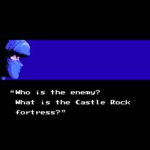


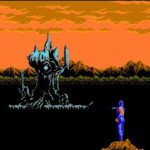
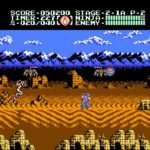
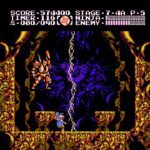
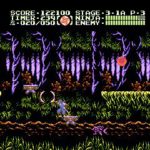
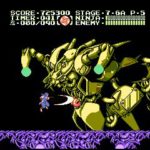

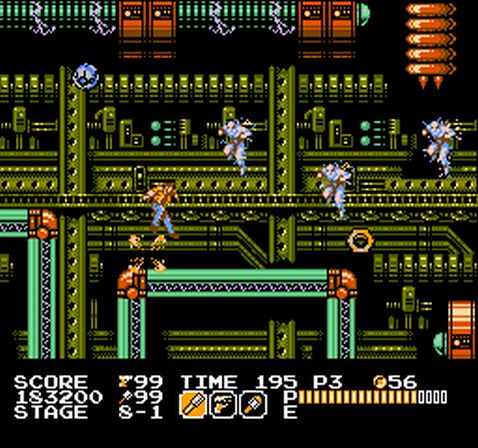


3 thoughts on “Ninja Gaiden III: the Ancient Ship of Doom”